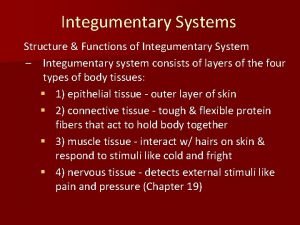The Integumentary System Chapter 6 Anatomy and Physiology



















































- Slides: 51

The Integumentary System Chapter 6 Anatomy and Physiology

Structure of Skin • Cutaneous Membrane: membrane that is the skin (organ) • Two layers 1. Epidermis: composed of epithelial tissue 2. Dermis: composed of connective tissue; vascular – Dermal-epidermal junction separates them • Hypodermis: subcutaneous layer of fat and areolar tissue beneath the dermis

Thick and Thin Skin • Of the epidermis • Thick Skin: – Found covering palms of hands, soles of feet, and other areas subject to friction – Contains all 5 layers of the epidermis – Dermal papillae are raised to form hand or foot prints – No hair

• Thin Skin – Number of cell layers in strata and number of strata is less – No ridges present – May contain hair

The Epidermis • Composed of Epithelial Cells – Keratinocytes: filled with keratin (a tough, fibrous protein); compose 90% of the epidermis – Melanocytes: give skin color and absorb UV radiation; may be absent in some areas – Langerhans Cells: play a limited role in immunological reactions


Cell Layers • 5 Layers or Strata in the Epidermis 1. Stratum corneum: superficial layer of epidermis • • • acts as a barrier for harmful agents that may enter the skin Made up of squamous cells containing keratin, which acts as a water repellant Keratinization: the process by which cells in this layer are formed from cells in deeper layers of the epidermis 2. Stratum lucidum: packed with keratinocytes; nuclei absent, and cells are filled with eleidin, which acts to block water loss or penetration and will eventually form keratin – Absent in thin skin

3. Stratum granulosum: keratinization starts here • • Cells in this region have started to degenerate, so nuclei are absent and a high number of lysosomes May also be absent in thin skin 4. Statum spinosum: 8 -10 layers of irregularly shaped cells • Rich in RNA for protein synthesis of keratin

5. Stratum basale: single layer of columnar cells – Cells undergo mitosis here and then migrate to the skins surface where they are shed

Epidermal Growth and Repair • Turnover and regeneration time: the time period required for a population of cells to mature and reproduce – About every 35 days a new layer of skin makes if from the stratum basale to the skin surface – Abrasions speed the process – Prolonged abrasions may cause calluses, or an increased thickness in the stratum corneum

Dermal-Epidermal Junction • Composed of basement membrane • Also includes fibrous elements and a polysaccharide gel that “glues” the epidermis to the dermis • Provides support to the epidermis and acts as a barrier against other cells and large molecules

Dermal-Epidermal Junction

Dermis • Composed of a thin papillary and thick reticular layer • Functions: – Provides protection against mechanical injury and compression – Reservoir for water and electrolytes – Nerves found in the dermis provide sensory – Vascular: contain blood vessels, which help to regulate body temp. – May also contain muscle fibers, hair follicles, and sweat and sebaceous glands

The Dermis

Papillary Layer of the Dermis • Composed of dermal papillae, which are bumps that project into the epidermis causing ridges that in some places are very well defined (fingerprints)

Reticular Layer of the Dermis • Composed of collagenous and elastic fibers, making the skin tough, yet stretchable • Serves as a point of attachment for skeletal and smooth muscles – Arrector pili muscles in the dermis are attached to your hair follicles that cause it to stand on end (goose bumps) – Skeletal muscles in the skin on the face • Sensory receptors for sensations such as pain, pressure, touch, and temperature can also be found here

Dermal Growth and Repair • The dermal layer does not continually repair itself like the epidermis • More common in wounds – Langer’s Lines: show the patterns of reticular fibers as they appear in different parts of the body • The directionality of a wound or incision determines how quickly it will heal • Stretch marks appear when the elastic fibers of the dermis are stretched too much or too rapidly


Skin Color • Determined by the quantity of melanin deposited in the cells of the epidermis

Melanin • Produced by the melanocytes of the stratum basale • The amount of melanin produced is determined by genetics, sun exposure, and secretion of hormones • Tyrosinase is the enzyme that regulates the process of melanin production • What condition do you think results from the congenital birth defect of no tyrosinase being manufactured in the cells?

Functions of the Skin • • Protection Sensation Movement without Injury Endocrine Excretion Immunity Temperature Regulation

Protection • Of underlying tissues from invasion of microorganisms • From dehydration • Melanin protects us from harmful effects of UV radiation • Surface Film helps in these processes: – Composed of a mixture of substances secreted by the sweat and sebaceous glands

Sensation • Of pressure, touch, temperature, pain, and vibration • Due to widespread placement of millions of different somatic sensory receptors in the skin • Allow for response to changes in the external and internal environment

Movement without Injury • Elasticity and growth of skin allows movement and growth without tearing or lacerating

Excretion • Plays a minor role in excretion of body wastes such as uric acid, urea, and ammonia

Endocrine Functions • Vitamin D Production – Begins in the skin when exposure to UV light – Causes a chemical to be converted and then transported to the liver and kidneys where it is converted to Vitamin D – Hormone: any substance that is produced in one body area and then is transported through the blood to another body area where it has an effect


Immunity • Langerhan cells, with the help of T-cells can trigger an immune reaction in certain diseases

Homeostasis • Constant temperature is needed in order for biochemical reactions to occur at certain rates • Heat Production: produced by the metabolism of foods by muscles and glands (liver) • Heat Loss: 80% occurs through the skin – Regulated by the vasoconstriction and vasodialation of blood vessels – Heat can then be lost through evaporation, radiation, conduction, and convection

• Evaporation: of fluid from the skin surface causes heat loss • Radiation: the transfer of heat from the body surface to nearby cooler objects (does not require contact between the two) • Conduction: the transfer of heat to any substance actually in contact with the body • Convection: transfer of air away from a surface by movement of heated air or fluid particles

Regulation of Heat Loss • Negative Feedback Loop – Detected by temperature receptors (sensor) – Message sent to the hypothalamus in the brain (integrator) – Hypothalamus sends a signal to the effector, which may be sweat glands or blood vessels

Skin Disease/Disorder Research • Define: – Dermatosis – Dermatitis • Research with a partner the skin disorder assigned to you and find the following information: – Symptoms: how it affects the skin or any skin appendages – What causes the disease or disorder – Any treatments – Pictures • Present your research in the form of a powerpoint presentation

Skin Disorders • Vitiligo • Basal and squamous cell carcinoma • Malignant melanoma • Acne • Eczema • Psoriasis • Scleroderma • warts • • Urticaria Decubitus Impetigo Tinea Hair loss/baldness Scabies Leprosy Seborrheic dermatitis

Burns • A thermal injury or lesion caused by contact of the skin with some hot object or fire, overexposure to UV light, electric current, or corrosive chemicals

Estimating Surface Area of Burns • Rule of Palms: the size of your palm represents approx. 1% of the surface area of your body • Rule of Nines: body is divided into 11 areas, each composing approx. 9% of the surface area of the body


Degree of Burn Injury • 1 st degree burns: causes minor discomfort and some redness of skin (sunburn); no blistering, minimal if any tissue destruction

• 2 nd Degree Burns: involves deep epidermal layers and upper layer of dermis – damage to skin appendages – Severe pain, swelling, blisters, scarring common

• 3 rd Degree Burns: destruction of epidermis and dermis, maybe even muscle or bone damage – Insensitive to pain due to nerve damage


Appendages on the Skin • Includes: – Hair – Nails – Glands

Hair • Types of Hair – Lanugo: covers a fetus; soft and fine hair – Vellus: replaces lanugo hair after birth; stonger, fine, with little pigment – Terminal: pubic and axillary hair appears at puberty (more on men than women)

Structures in the Hair • Follicle has two layers – Outer dermal root sheath – Epithelial root sheath • Germinal matrix: cap of cells at the base of the follicle • Papilla: small mound of dermis; contains capillaries that supply the germinating matrix

• Shaft: visible part of the hair • Medulla: inner core of the hair • Cortex: surrounds medulla; made of layers of keratinized cells that contain melanin

Hair Color and Texture • Melanin is responsible for hair color – Dark hair: more melanin – Red hair: unique melanin that contains iron – White or gray: no melanin • Texture of hair depends on the shape of the shaft – Straight hair: round, cylindrical shaft – Wavy hair: flat shaft; not as strong

Hair Trivia • Hair alternates between periods of growth and rest and grows on average about ½ inch a month • Head hair lives between 2 -6 years • Cutting or shaving your hair does NOT make it grow faster • Hair does NOT continue growing after death

Nails • Made of keratinized epidermal cells • Nail Root lies under the fold of skin known as the cuticle • Lunula: crescentwhite shaped area on nail • Nails grow about 0. 5 mm a week

Skin Glands • Three kinds of skin glands – Sweat – Sebaceous – ceruminous

Sweat Glands • Most numerous • Two groups – Eccrine: throughout the body produce sweat rich in salts, ammonia, uric acid, urea, and other wastes • Sweat aids in the rid of wastes and temperature control – Apocrine: located in the armpit, areola of the breast, and around the anus; begin to function at puberty to release a more viscous and colored secretion than eccrine glands

Sebaceous Glands • Secrete oil (sebum) for the hair and skin • Two glands for each hair • Aids in preventing water loss, contains anti-fungal properties

Ceruminous Glands • Special variety or modification of apocrine glands found in the ear canal • Secrete cerumen, which is a brown waxy substance that protects the skin in the ear canal from dehydration, but can harden and cause blockage
 Anatomy and physiology chapter 8 skeletal system
Anatomy and physiology chapter 8 skeletal system Anatomy and physiology unit 7 cardiovascular system
Anatomy and physiology unit 7 cardiovascular system Respiratory system
Respiratory system Chapter 14 anatomy and physiology
Chapter 14 anatomy and physiology Waistline
Waistline Anatomy and physiology chapter 8 special senses
Anatomy and physiology chapter 8 special senses Chapter 13 anatomy and physiology of pregnancy
Chapter 13 anatomy and physiology of pregnancy Anatomy and physiology chapter 2
Anatomy and physiology chapter 2 Anatomy and physiology chapter 7
Anatomy and physiology chapter 7 Anatomy and physiology coloring workbook figure 14-1
Anatomy and physiology coloring workbook figure 14-1 Chapter 10 blood anatomy and physiology
Chapter 10 blood anatomy and physiology Anatomy and physiology chapter 15
Anatomy and physiology chapter 15 Anatomy and physiology chapter 1
Anatomy and physiology chapter 1 Holes anatomy and physiology chapter 1
Holes anatomy and physiology chapter 1 Gi tract histology
Gi tract histology Medial and lateral
Medial and lateral Chapter 2 human reproductive anatomy and physiology
Chapter 2 human reproductive anatomy and physiology Chapter 6 general anatomy and physiology
Chapter 6 general anatomy and physiology 2012 pearson education inc anatomy and physiology
2012 pearson education inc anatomy and physiology Unit 3 integumentary system
Unit 3 integumentary system Chapter 6 integumentary system
Chapter 6 integumentary system Upper respiratory labeled
Upper respiratory labeled Tattoo anatomy and physiology
Tattoo anatomy and physiology Anatomy science olympiad
Anatomy science olympiad Specialized stems examples
Specialized stems examples Bone metabolism
Bone metabolism Peptic ulcer anatomy and physiology
Peptic ulcer anatomy and physiology Cantlie line
Cantlie line Epigastric region
Epigastric region Iliac regions
Iliac regions Google
Google Human anatomy and physiology seventh edition marieb
Human anatomy and physiology seventh edition marieb Http://anatomy and physiology
Http://anatomy and physiology Appendectomy anatomy and physiology
Appendectomy anatomy and physiology Aohs foundations of anatomy and physiology 1
Aohs foundations of anatomy and physiology 1 Aohs foundations of anatomy and physiology 1
Aohs foundations of anatomy and physiology 1 Anatomy and physiology of swine
Anatomy and physiology of swine Unit 26 animal anatomy physiology and nutrition
Unit 26 animal anatomy physiology and nutrition Science olympiad anatomy and physiology 2020 cheat sheet
Science olympiad anatomy and physiology 2020 cheat sheet Physiology of stomach ppt
Physiology of stomach ppt Anatomy and physiology diabetes
Anatomy and physiology diabetes Aohs foundations of anatomy and physiology 1
Aohs foundations of anatomy and physiology 1 Aohs foundations of anatomy and physiology 1
Aohs foundations of anatomy and physiology 1 Anatomy and physiology
Anatomy and physiology Cornell notes for anatomy and physiology
Cornell notes for anatomy and physiology Anatomy and physiology ninth edition
Anatomy and physiology ninth edition Holes essential of human anatomy and physiology
Holes essential of human anatomy and physiology Anatomy and physiology
Anatomy and physiology The speed at which the body consumes energy
The speed at which the body consumes energy Aohs foundations of anatomy and physiology 1
Aohs foundations of anatomy and physiology 1 Human physiology exam 1
Human physiology exam 1 Welcome to anatomy and physiology
Welcome to anatomy and physiology










































































